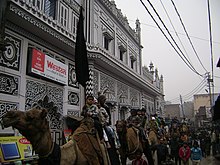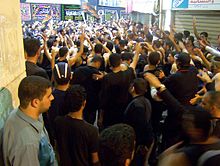24th OCTOBER 2015 MUHARRAM TAZIYA (10th DAY)
Mourning of Muharram
From Wikipedia, the free encyclopedia
| This article needs additional citations for verification. (May 2011) |
| Mourning of Muharram | |
|---|---|

2008 Mourning of Muharram around the Imam Husayn Shrine in Karbala, Iraq. The city, best known as the location of the Battle of Karbala, one of the holiest shrines for Shia.
| |
| Type | Islamic and national (In many countries such as India,Pakistan, Iraq, Iran, Turkey,Afghanistan, Syria, Nigeria,Tanzania, Saudi Arabia,Bangladesh, Yemen, Bahrain,Azerbaijan and Lebanon) |
| Significance | Marks the death of Hussein ibn Ali (Shi'a Islam, Sunni Islam[citation needed]); The day that Moses fasted as gratitude for the liberation of the Israelites (Sunni Islam) |
| Observances | Mourn and derive messages from Hussein's Sacrifice (Shi'a Islam); Fasting (Sunni Islam) |
| 2014 date | October 26 |
| 2015 date | October 14 |
| 2016 date | October 2 |
| 2017 date | September 21 |
See also: Day of Ashura
| Mourning of Muharram |
|---|
| Events |
| Figures |
| Places |
| Times |
| Customs |
| A series of articles on |
| Husayn ibn Ali, the 2nd Ismaili & 3rd Sevener, Twelver and ZaydiImam of Shia Islam Muhammad's grandson |
|---|
 Husayn ibn Ali in Islamic calligraphy Husayn ibn Ali in Islamic calligraphy |
| Life |
| Remembrance |
|
| Perspectives |
The Mourning of Muharram, Remembrance of Muharram, or Muharram Observances, is a set of rituals associated with Shia Islam, which takes place in Muharram, the first month of the Islamic calendar. Many of the events associated with the ritual take place in congregation halls known as Hussainia.
The event marks the anniversary of the Battle of Karbala when Imam Hussein ibn Ali, the grandson of Muhammad, and a Shia Imam, was killed by the forces of the second Umayyad caliph Yazid I at Karbala. Family members, accompanying Hussein ibn Ali, were killed or subjected to humiliation. The commemoration of the event during yearly mourning season, from first of Muharram to twentieth of Safar with Ashura comprising the focal date, serves to define Shia communal identity.[1] At present, Muharram Observances are carried out in countries with noteworthy Shia population, including Afghanistan, Azerbaijan, Iran, Iraq, Pakistan, Lebanon,India, and Bahrain.[2]
Contents
[hide]Etymology[edit]
The words Azadari (Persian: عزاداری) which mean mourning and lamentation; and Majalis-e Aza have been exclusively used in connection with the remembrance ceremonies for the martyrdom of Imam Hussain. Majalis-e Aza, also known as Aza-e Husayn, includes mourning congregations, lamentations, matam and all such actions which express the emotions of grief and above all, repulsion against what Yazid stood for.
Expression of grief with thumping of the chest by Shia Muslims is also known as Latmya, Latmaya or latmia in Arabic-Persian countries. In India and Pakistan it is called Matam or Matam-Dari/Sina Zannee (chest beating).[3]
The term majalis has both a grammatical meaning and a meaning which relates to Aza-e-Husayn. In its technical sense, a majalis is a meeting, a session or a gathering.
Background[edit]
According to Shia sources, The Azadari of Muharram was started by the family of Muhammad (the Ahl-ul-Bayt) after the death of his grandson Husayn ibn Ali at the Battle of Karbala in 680 AD. Following the battle of Karbala, Muhammad's granddaughter Zaynab bint Ali and sister of Imam Husayn, began mourning for the fallen and making speeches against Imam Husayn ibn Ali's opponents: Ibn Ziyad and Yazid I. News of Imam Husayn ibn Ali's death was also spread by Imam Zain-ul-Abideen, who succeeded Imam Husayn as the Shia Imam, via sermons and speeches throughout Iraq, Syria and Hejaz.
Zainab and Imam Zain-ul-Abideen informed the people that Yazid had martyred Imam Imam Husayn and seventy-two of his companions including his six-month-old son Ali Asghar, and that their women and children were taken as prisoners to Syria. When word of mourning reached Yazid he decided to release the captive women and children from the prison in Damascus, out of fear of public revolt against his rule. He sent for Imam Zain-ul-Abideen, informed him of the impending release and asked if he wished for anything further. Imam Zain-ul-Abideen said he would consult with Zainab. She asked Yazid to provide a place where the people could mourn for Imam Husayn and others of Muhammad's household. A house was provided, and here Zaynab bint Ali held the first Majlis-e Aza of Imam Husayn and started the Mourning of Muharram.[citation needed]
History of commemoration[edit]
The mourning and commemoration for Imam Husayn ibn Ali originated in Iraq, as this is where Imam Husayn was martyred. However, they were held in Iran as early as the twelfth century, when both Sunnis and Shias participated in them. In the Safavid period, the annual mourning ceremonies for Imam Hussein, combined with the ritual cursing of his enemies, acquired the status of a national institution. Expressions of grief such as sine-zani (beating the chest), zangir-zani (beating oneself with chains), and tage-zani or Qama Zani also known as Tatbeer (hitting oneself with swords or knives) emerged as common features of the proliferating mourning-processions (dasta-gardani). Mourning for the martyred Imam also takes place in assemblies held in buildings erected especially for the purpose, known either as Hussainia or takia, as well as in mosques and private houses.
In Iran, people perform their Imam's funeral by carrying a huge wooden structure called "Nakhl", which is usually carried by several hundred men.[5]
Azadari in Lucknow[edit]
Main article: Azadari in Lucknow
In Lucknow, India, the Muharram processions and rituals are known as Azadari. The processions, including the Chup Tazia, have been observed since the sixteenth century or earlier, when Lucknow was capital of the state of Awadh.
In the 20th century, beginning in 1906, Azadari became a focus of communal tension in Lucknow. In 1977, after riots broke out for the fourth time since 1968, the government of Uttar Pradesh banned the Azadari processions. Shia leaders protested the ban, and many Shia Muslims courted arrest by defying the ban each year.
In 1997 a hunger strike was launched to protest the Azadari ban. In April three Shia youths committed self-immolation and died. A noted Shia scholar called for a peace march on 18 April 1997 that reportedly drew more than 200,000 Shias.[citation needed]
Late in the year, after months of arrests and clashes between police and protesters, the government granted limited permission for Shias in Lucknow to hold Azadari processions.
Types of mourning[edit]
| [hide] |
|---|
 |
| Shia Islam portal |
How the event is mourned differs between different branches of Shia and different ethnic groups. The event is also observed by many Sunnis, but to a lesser extent, and as a time of remembrance, rather than mourning. The Nizam of Hyderabad/Deccan Mir Osman Ali Khan, was not only a Sunni Muslim and the famous powerful ruler of Hyderabad DeccanState till 1948 but also great lover of Ahle Bait and promoter of Azadari.[6]
In the Twelver three traditional schools (Usooli, Akhbari, and Shaykhi), mourners, both male and female, congregate (in separate sections) for sorrowful, poetic recitations performed in memory of the death of Husayn, lamenting and grieving to the tune of beating drums and chants of "Ya Husayn." Passion plays are also performed, reenacting theBattle of Karbala and the suffering and death of Husayn at the hands of Yazid. They offer condolences to Imam-e-Zamana also known as Imam al-Mahdi whom they believe will avenge the blood of Husayn and bring justice to the world.
Bektashis and Alevis also mourn, and they keep themselves from eating and drinking ("fasting") the first 10–12 days of Muharram. In this period, the Alevis wear black clothes, do not shave themselves and avoid any type of entertainment and pleasure. Originally, it was also forbidden to bathe and change clothes during this period, but today most Alevis do not follow this rule. This is called "Muharrem Matemi", "Yas-i Muharrem" or "Muharrem orucu". But because it is also called "fasting", many people falsely think that Alevis celebrate the Muharram. The definition of the "fast" in this connection is different from the normal type of "fasting". Bektashis also greet each other by saying "Ya Imam! Ya Husayn."
The only Ismaili group which mourns are the Mustaali, who mourn similarly to the majority of Twelvers. Although, Nizari Ismaili commemorate Muharram through the tradition of not celebrating marriages, birthdays, and other religious celebrations during this time to show respect to there other Muslim brothers who are mourning.
For the duration of the remembrance, it is customary for mosques to provide free meals (nazar) on certain nights of the month to all people. These meals are viewed as being special and holy, as they have been consecrated in the name of Imam Husayn, and thus partaking of them is considered an act of communion with Allah, Imam Husayn, and humanity.
In South Asia, a number of literary and musical genres, produced by both Shias and Sunnis, that have been inspired by the Battle of Karbala are performed during the month, such as marsiya, noha and soaz. This is meant to increase the peoples understanding of how the enemies fought The Battle of Karbala against Husayn and his followers. In Trinidad and Tobago and Jamaica[7] all ethnic and religious communities participate in the event, locally known as "Hosay" or "Hussay". In Indonesia, the event is known as Tabuik (Minangkabau language) or Tabut (Indonesian).[8]
Pilgrimage of Imam Husayn Shrine[edit]
Main articles: Imam Husayn Shrine and Ziarat
Many Shia also tend to embark on a pilgrimage to the Imam Husayn Shrine in Karbala itself, as it is one of the holiest places for Shias outside of Mecca and Medina. Up to one million pilgrims a year visit the city to observe the anniversary of Imam Husayn ibn Ali's death. [9] The shrine is located opposite that of Al-Abbas ibn Ali.
Matam[edit]
The Arabic term matam refers in general to any act or gesture of mourning; in Shia Islam the term designates acts of lamentation for the martyrs of Karbala.[10] Many of the male and female participants congregate in public for ceremonial chest beating (matam) as a display of their devotion to Imam Husayn and in remembrance of his suffering.[11] In some Shi'a societies, such as those in Bahrain, Pakistan, India, Afghanistan and Iraq, some male participants incorporate knives or razors swung upon chains into their matam. There are two basic forms of matam:[12][13][14]
- matam using one's hands only, that is, sineh-zani or breast-beating
- matam with implements like chains, knives, swords and blades, that is, zanjeer-zani, qama-zani, etc.
Matam in South Asia is the most significant and sensitive Shia identity marker.[13]
Taziya[edit]
Main article: Ta'zieh
One form of mourning is the theatrical re-enactment of the Battle of Karbala. In Iran this is called taziya or taziyeh. Theatrical groups that specialize in taziya are called taziya groups.[15] Taziyas were popular through the Qajar dynasty until the early twentieth century, but the re-enactments slowly declined until they were mostly abandoned in the large cities by the early 1940s. Nonetheless, taziyas continued to exist in Iran on a smaller scale especially in more rural and traditional areas. Reza Shah, the first of the Pahlavi dynasty, had outlawed taziyas. Despite some attempts since 1979, Muharram processions and various forms of the rawza khani are still more common.[16]
Shia Hadiths[edit]
Muhammad said:
Muhammad said:
Imam Ali ibn Hussein said:
Imam Ali said to Abdullah Ibn Abbas:
Origin and reason for mourning[edit]
Zaynab binte Ali, sister of Imam Husain, after Karbala vowed that as long as the people do not recognise the actual cause of Karbala, the followers of Imam Hussain will continue to protest on the streets and in the dwellings as to what happened in Karbala. She organized first majlis (mourning-assembly) while still in Damascus in honour of Imam Husain.[10]
Though besides Sunnis some Shias do not know that it is a protest and invitation to people to come and listen to mourners as to what happened in Karbala. It is believed by some non-Shias that Imam Hussain's journey to Karbala was to claim his Imamat over the people of Kufa who had written letters inviting him to Kufa whereas per Shia's belief Imam Husain knew he was to be killed there. He undertook this journey to deny his approval or Bay'at to Yazid becoming caliph because he considered Yazid to be a danger to the Muslim Ummah and a threat to Islam. His sacrifice and revolution were to preserve Islam and his Grandfather's Ummah against the innovation, hypocrisy, wickedness as well as the attempts to destroy and alter Islam and the quest for worldly pleasures and worldly gains by Yazid and his people.
See also[edit]
- Tatbeer or Qama Zani and Zanjeer zani
- Marsia
- Noha
- Soaz
- Ta'zieh
- Hussainia
- Hosay
- Carpet Washing Ceremony
- Holy Week, a week-long festival of mourning for the death of Jesus observed by Roman Catholics.
Search Results
Mourning of Muharram - Wikipedia, the free encyclopedia
https://en.wikipedia.org/wiki/Mourning_of_Muharram
Jump to Taziya - Taziya[edit]. Main article: Ta'zieh. Indian Shia Muslims take out aTa'ziya procession on day of Ashura in Barabanki, India, Jan, 2009.
2014 date: October 26
2016 date: October 2
2015 date: October 14
2017 date: September 21
Muharram Tazia Procession in Jaipur - YouTube
https://www.youtube.com/watch?v=OocPt8xGdH4
Dec 8, 2011 - Uploaded by jaipurthepinkcity
Muharram Video - Muharram Tazia Procession in Jaipur:- Muharram is the first month of Islamic calender ...Muharram tazia - YouTube
www.youtube.com/watch?v=Pn6rC2nt84s
Nov 25, 2012 - Uploaded by Syeddanish Karim
this is the video of tazia of tenth muharram at bhagalpur.Bada Tazia 10th Muharram | Allahabad Azadari by Ahl-e ...
www.youtube.com/watch?v=dx8pZhQACg4
Dec 10, 2011 - Uploaded by TashooAlvi
Bada Tazia 10th Muharram | Allahabad Azadari by Ahl-e-Sunnat | 6th Dec 2011.Patni Tazia Jamnagar, Muharram 2013 Video 07 - YouTube
www.youtube.com/watch?v=hnGclisMNZk
Nov 15, 2013 - Uploaded by Saleem Ismail
Patni Tazia Jamnagar, Muharram 2013 Video 07 upload by Shoaib Patni, Jamnagar.The World's Best Photos of tazia - Flickr Hive Mind
flickrhivemind.net/Tags/tazia/Interesting
Bada Imambara Interior and Tazias-002 (ramesh_lalwani) Tags: lucknow tazia badaimambara. astp-07 (taziadari) Tags: muharram tazia tajia taziya samundari ...TAZIA DARI (History of Tazia-e-IMAM HUSSAIN as ...
https://www.facebook.com/media/set/?set=a.382429185180622...3
Fourteen centuries later, one may wonder how the events of Karbala transformed into the Muharram rituals as practiced today. Earlier, the followers of Hussain ...Tazia Stock Photos / Pictures / Photography / Royalty Free ...
https://www.inmagine.com/searchterms/tazia.html
Stock photo, image, picture, photography of tazia. ... Man decorating Tazia at a mosque during Muharram,Jama... PTG01514315. Decorated Tazias at a mosqueHindu's tazia to lead Muharram procession - Times of India
timesofindia.indiatimes.com › City
Oct 14, 2014 - Along with SalimShaikh, Kanojiya is preparing a tazia for Muharram that falls on November 5. Kanojiya'stazia, though small in size, leads the ...Searches related to muharram taziya
Kharghar, Navi Mumbai, Maharashtra - From your Internet address - Use precise location
Did you mean: muharram tazia
Search Results
Muharram Tazia Procession in Jaipur - YouTube
https://www.youtube.com/watch?v=OocPt8xGdH4
Dec 8, 2011 - Uploaded by jaipurthepinkcity
Muharram Video - Muharram Tazia Procession in Jaipur:- Muharram is the first month of Islamic calender ...Muharram tazia - YouTube
www.youtube.com/watch?v=Pn6rC2nt84s
Nov 25, 2012 - Uploaded by Syeddanish Karim
this is the video of tazia of tenth muharram at bhagalpur.Patni Tazia Jamnagar, Muharram 2013 Video 07 - YouTube
www.youtube.com/watch?v=hnGclisMNZk
Nov 15, 2013 - Uploaded by Saleem Ismail
Patni Tazia Jamnagar, Muharram 2013 Video 07 upload by Shoaib Patni, Jamnagar.Bada Tazia 10th Muharram | Allahabad Azadari by Ahl-e ...
www.youtube.com/watch?v=dx8pZhQACg4
Dec 10, 2011 - Uploaded by TashooAlvi
Bada Tazia 10th Muharram | Allahabad Azadari by Ahl-e-Sunnat | 6th Dec 2011.HUGE TAZIA (MUHARRAM, MOHARRAM). BHEEKPUR ...
www.youtube.com/watch?v=cqyiw0218xs
Dec 30, 2010 - Uploaded by Mohsin Rizvi
The height of this tazia is 72 FT. and lifted in the occasion ofMoharram (MUHARRAM TAZIA 2012 IN DAMAN INDIA - YouTube
www.youtube.com/watch?v=IuXdNT5M15E
Jan 16, 2013 - Uploaded by Maifuse Kadri
MUHARRAM TAZIA 2012 IN DAMAN INDIA ... Hii am frm Mauritius, would love u explain me more ...Tazia Juloos of Muslims in Ahmedabad Gujarat on ...
www.youtube.com/watch?v=KwylKiMl1Mk
Nov 15, 2013 - Uploaded by DeshGujaratHD
Tazia Juloos of Muslims in Ahmedabad Gujarat on Muharramfestival.jamnagar patni tazia muharram 2011 video 07 - YouTube
https://www.youtube.com/watch?v=DpA8kpFJLYU
Dec 10, 2011 - Uploaded by Saleem Ismail
jamnagar patni tazia muharram 2011 video 07 ... alahazrat ka maslak hame tazie banana nahi sikhata ...muharram jaipur 2012 tazia art 2 - YouTube
www.youtube.com/watch?v=5CFumxWl8D4
Nov 28, 2012 - Uploaded by rafat alam
Tazia making is a craft of love.Devoted craftmen start minute work with bamboo pieces ,cloth ,paper ,tharmacol ...Muharram ( Taziya ) JAORA ( jahangeer Niyazi) - YouTube
www.youtube.com/watch?v=F9YxI9LBuz4
Sep 14, 2011 - Uploaded by S Jaani
Muharram Sharif In Jaora ( Joloos ) On 9th Muharram 1431 ( 2010) ( jahangeer Niyazi)
Stay up to date on results for muharram taziya.
Create alert













No comments:
Post a Comment